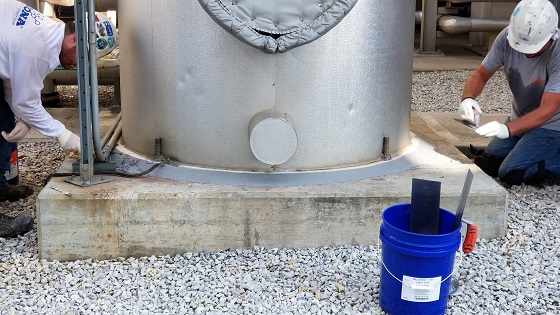For the five-person crew from Belzona distributor Industrial Repair Technology, led by General Manager Jason Kraft, the coating work at a clean gas-driven power plant was quite detailed. The project included two inlet ducts and bell mouths for a turbine intake at Dogwood Energy in Pleasant Hill, Missouri. Each inlet was approximately 1,000 square feet (92.3 m2) and had to be accessed, prepped, and coated before the crew could call it complete.
It took the crew one week to prep and one week to coat each of the turbines — but this project would prove not to be as straightforward in reality as it sounded on paper.
Safety in Small Spaces
The contracting company, based in suburban Kansas City, Missouri, is a certified dealer of and applicator for Belzona materials, with United States headquarters in Miami, Florida. The turbines required the use of Belzona 5892. But first they had to get access to the area.
Because the turbines were considered confined spaces, the crew not only had to have training, but they also had to wear harnesses for extraction and use a hole monitor at all times. The training included Occupational Safety & Health Administration (OSHA) 10 for crew members and OSHA 30 for the foremen and safety officer. In addition to that, they had to complete the local plant safety training process and monitor the air to meet OSHA’s permit-required confined spaces.
The crew also had to have hot work permits if any sparks were expected to be created. The inlet areas were used for wet compression and fogging projects, and that’s another reason why these specific materials were chosen for this project: The two-part 5892 epoxy is able to withstand high temperatures up to 203 °F (95.0 °C). Although equipment at the facility runs hot, during the project the turbines were locked out, tagged out, and were completely deenergized when the crew was on site.
Prep and Coat
When it came to the actual application, the Industrial Repair Technology crew had to start by preparing the galvanized steel. They protected other surfaces with heavy plastic before using Schmidt by Axxiom 3.5-cubic-foot (0.1 m3) blast pots and a Radex airless filter along with Black Beauty coal slag. That was to create an average 3-mil (76.2 microns) profile and in adherence to
NACE No. 1/Society for Protective Coatings (SSPC) Surface Preparation (SP) 5: White Metal Blast Cleaning standard.

The crew was sure to wear proper protective equipment (PPE) throughout the job, including non-cut gloves, steel-toed boots, safety glasses, and hard hats. If any member of the crew was working on the site-provided green-tagged scaffolding, at 3 feet (0.9 m) or more off the ground, he or she had to wear Guardian fall protection gear.
The crew also paid particularly close attention to safety gear during the prep stage, where they wore Allegro Nova helmets. They held daily safety meetings and maintained jobsite hazard analysis documentation.
Once the surfaces were prepped and wiped down, the crew was able to move on to the coatings. Using wet film thickness gages, the crew used brushes and a Titan 440 airless sprayer to apply a total average of 20 mils (508.0 microns) dry film thickness. That was installed in two layers at about 10 mils (254.0 microns) each. Once cured, the crew used a sponge test and pull off gage, per a NACE Level 3 report.
 The epoxy is solvent-free and, therefore, didn’t require a respirator when applying. But because this project took place in the Midwest in September and October, which run a bit colder than earlier months, the crew was sure to keep materials in a controlled environment at the jobsite’s designated staging area.
The epoxy is solvent-free and, therefore, didn’t require a respirator when applying. But because this project took place in the Midwest in September and October, which run a bit colder than earlier months, the crew was sure to keep materials in a controlled environment at the jobsite’s designated staging area.
Solution That Saves
According to Kraft, several crew members were “vital in the application process”: Stephen Palmer, Mark Greathouse, Ben Bruce, and Jon Bruce. After cleanup, which included using Blastrac BDC-1216 high-efficiency particulate air (HEPA) vacuums to finish removing any spent abrasives, the Industrial Repair Technology crew was able to call it a day.
“We delivered back an amazing long-term solution that has led to many more applications at the same power plant,” Kraft said. According to the general manager, when compared to other products and services, this crew was able to deliver a solution that saved the client around $60,000. Those are potentially big savings from a seemingly small solution.